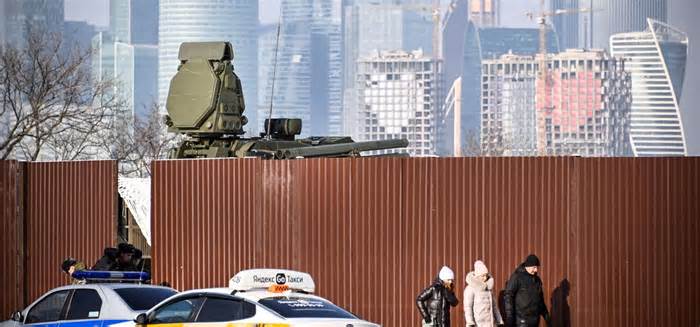In recent months, Ukraine has stepped up its missiles and drones on critical targets in Russia. The escalation is a reaction to Russian attacks on Ukraine’s civilian infrastructure and Ukraine’s recent approval of the use of foreign aid missiles opposed to targets in Russia. For its part, Russia runs to its domestic sites from these movements. However, its existing air defense functions are inadequate to sound the giant number of prospective targets, prompting Russia to seek strategies of choice to counter the developing number of Ukrainian aircraft.
Russia’s air defense arsenal, like much of its military generation, combines complex modern systems with advanced Soviet-era equipment. During the Cold War, Russia gained extensive experience in generating air defense to counter Western aircraft. Today, its air defense program uses a layered strategy. Long-diversity systems, such as the S-500 Prometheus, are capable of targeting hypersonic missiles and satellites in low-Earth orbit. The S-400 Triumf, a complex system, can have interaction targets up to 400 kilometers away, adding aircraft, drones and ballistic missiles. Soviet-era platforms are complemented through those high-end systems, as well as Soviet-era platforms such as the S-300 series, as well as the Buk and Tor systems, which provide medium-diversity and short-diversity cellular defense. Together, these parties create overlapping policies opposed to a wide range of aerial threats.
Despite its impressive diversity of air defense systems, Russia faces significant shortages. Russia has prioritized deploying those systems to protect its frontline troops in Ukraine. However, the needs to cover a six-hundred-mile front and 35 months of heavy fighting have caused significant losses. According to oryxspioenkop. com, Ukraine has destroyed 274 Russian air defense systems, although Ukrainian officials claim that this figure is much higher. These losses are as follows: “It is increasingly difficult for Russia to ensure sufficiently good coverage of national sites while proceeding to protect its forces in Ukraine. “
The shortage of air defense systems is exacerbated by the greater diversity of Ukrainian missiles and drones. Ukraine now has permission to use American strikes and British Typhoon shadow missiles in opposition to military targets in Russia. Meanwhile, Ukraine is strengthening its domestic production of missiles and drones. This puts further pressure on Russia’s already scarce air defense resources, as the increasing diversity of such missiles expands the number of potential targets requiring protection.
Another challenge is that many of Russia’s air defense systems rely on Soviet-era technology. Like all military technology, air defense systems are components of a consistent game of cat and mouse, with new missiles designed to evade older defenses. This limits the effectiveness of Russia’s Soviet-era apparatus opposed to Ukraine’s functions for progress. In addition, Ukraine’s state-of-the-art commercial base continues the endurance and effectiveness of its drones and missiles, posing an even greater challenge to Russian defenses.
Given those disruptions with its traditional air defense assets, Russia is running to expand and box new formulas, primarily attacking Ukrainian drones that make up a significant component of the strike programs. One such formula is the SFera drone detection and suppression formula, evolved through the Russian state defense Rostec in combination with the Polet Chelyabinsk radio plant. This formula is designed to protect civilian spaces from drone attacks and would have a diversity of several square kilometers.
In addition, Russia can also download air defense formulas from its allies. In particular, Russian Milbloggers recently stated that Russian forces are now using a North Korean analogue of the Tor Air Defense Formula. A symbol has appeared that represents the North Korean formula; Its location, either in Ukraine or in Russia, is not clear. One of those formulas was recently destroyed in Kursk, where the Russian army confused her with a Ukrainian formula.
The Reddit Post’s social media capture describes this symbol as the installation of NetSArray anti-Drone. [] On “critical infrastructure” in Moscow.
To further enhance their defenses, potential Russian targets have pursued various unconventional air defense techniques, in addition to installing giant nets around critical infrastructure to trap incoming drones. These steel nets, supported by auxiliary beams and cables, are designed so that drones can trip over them, causing them to become tangled and explode prematurely. However, several Russian services have implemented such networks, but they are not a deterrent of impermanence, as the Ukrainians are devising techniques to stumble upon such networks and avoid them.
As Ukraine ramps up its missile and drone attacks, Russia is preparing for a sustained attack. Given the intensity of Russia’s missile campaigns, there is little explanation for why to expect Ukraine to relent. Air defense temporarily conforms to a very sensible precedence for Russia, with intermediate measures in place to address existing shortages. If those measures prove insufficient, Russia’s dangers waste infrastructure and resources are imperative to the continuation of its war effort against Ukraine.
A community. Many voices. Create a free account to share your thoughts.
Our network is about connecting other people through open and considered conversations. We need our readers to prove their reviews and exchange concepts and made in a space.
In order to do so, please follow the posting rules in our site’s Terms of Service. We’ve summarized some of those key rules below. Simply put, keep it civil.
Your message will be rejected if we realize that it seems to contain:
User accounts will be blocked if we notice or believe that users are engaged in:
So how can you be a rude user?
Thank you for reading our network regulations. Please read the complete list of publishing rules that are the situations of use of our site.

